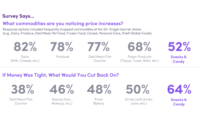
No sugar? No problem. According to the American Diabetes Association (ADA), 7.8% of the U.S. population has diabetes, and that number is growing. While diabetics search for ways to satisfy sweet teeth while staying within dietary guidelines, other Americans simply want to control their waistlines. It’s lucky for both that the confectionery industry is there to help.
One of the first companies to make these goals possible was Asher’s Chocolates, whose sugar-free chocolates were diabetic friendly as early as the 1960s, if not as tasty as they are today.
“The advance of maltitol and some other things have really made the chocolate and the centers taste better,” says Jeff Asher, vice president of sales and marketing. “The chocolate has come a long way.”
Today, Asher's offers more than 50 sugar-free bulk chocolates, along with sugar-free fudges, bars, truffles and even seasonal chocolates.
The company’s newest offering is a no sugar addedFigaro piece, which features a layer of sugar-free dark chocolate mixed with hazelnut and another layer of sugar-free milk chocolate mixed with hazelnut. Asher’s plans to expand its sugar-free chocolate bar line as a result of the increased activity in the sugar-free category, a well.
Guylian USA, Englewood Cliffs, N.J., also uses maltitol as a sweetener in its no sugar added chocolate bars. And thanks to consumers’ increased interest in dark chocolate, the company’s Belgian chocolate bars now come in three different dark chocolate varieties, along with one milk chocolate variety.
Many Americans still prefer milk chocolate, says Brad Maslan, president of Guylian.
“People are learning to like dark chocolate,” he adds. “The dark chocolate out there - sugar-free and sugar - is better tasting than it was in the past.”
Whether it’s dark or milk chocolate consumers prefer, Guylian’s no sugar added chocolate bars offer a “better-for-you” alternative. They come in dark, 70% extra dark, dark with orange and milk chocolate varieties.

Not Just for Diabetics
While sugar-free chocolates seemed to reach their height during the low-carb craze, many consumers still are drawn to the category.“Sugar-free chocolates are enjoyed by many different types of consumers,” says Emily Korns, communications manager/registered dietitian, Mars Health & Nutrition. For example, “They are a good option for well-controlled diabetics who are working closely with a health professional to manage their blood glucose,” she adds. “For this consumer,Dove sugar-free chocolates provide a delicious indulgence, but have a lower carbohydrate content that can fit into their meal plan.” Mars’ sugar-freeDove dark chocolates come in Chocolate Crème, Mint Crème and Raspberry Crème flavors.
“Another group that seeks out sugar-free chocolates is consumers who are trying to manage their weight,” Korns notes. “There are several weight management plans that limit total carbohydrates and added sugar. So while not a low calorie or low fat food, sugar-free chocolate can fit into a diet where consumers choose to limit sugar intake.” To aid in weight management, each piece ofDove’s sugar-free chocolate is 38 calories.
Meanwhile, Russell Stover Candies, Inc. offers a variety of sugar-free chocolates. In fact,Russell Stoverbrand sugar-free chocolates topped Information Resources, Inc.’s list of best-selling sugar-free chocolate candy, latest 52 weeks ending Dec. 28, 2008. Russell Stover’sPrivate Reserveline is a premium sugar-free chocolate offering, consisting of four varieties: 60% Cacao Dark Chocolate, Triple Chocolate Mousse, Vanilla Caramel and Raspberry Soufflé with 60% Cacao Dark Chocolate. Each piece is individually wrapped and sweetened withSplenda sucralose. Russell Stover Candies, Inc. also produces theWhitman’s andPangburn’s brands, which offer their own sugar-free chocolates.

Taste and See
While portion control is an added benefit for sugar-free chocolates, taste still is the No. 1 concern for manufacturers … and consumers.“Taste is the most important factor in purchasing sugar-free chocolates and candies,” says Anna Lingeris, public relations manager for The Hershey Co. “Consumers enjoy traditional Hershey’s products, but are also requesting a wider variety of sugar-free products.”
To appease consumer interest, the company recently launchedHershey’s Sugar Free Caramel filled Chocolates. Additionally, the company offersHershey’s Sugar Free Chocolates,Hershey’s Sugar Free Special Dark Chocolates,Reese’s Sugar Free Peanut Butter Cups andYork Sugar Free Peppermint Patties.
Along with its expanding variety of sugar-free chocolates, “Hershey’s recently reformulated their sugar-free chocolates to deliver a richer and [more] chocolaty taste and texture to their consumers,” Lingeris adds.
By using sugar alcohols in its sugar-free chocolates, Hershey’s can delay the rise in a consumer’s blood sugar levels. This happens because sugar alcohols are digested more slowly than sugar, according to the company.
With diabetics being a main consumer of sugar-free products, it’s no wonder a diabetic decided to start his own sugar-free company. President Gary Russell opened Fifty50 Foods in 1991 with the notion of giving half the company’s profits to diabetes research. Since the company’s start, it has donated more than $11 million to the cause. The company’s chocolate products include four varieties of chocolate bars: milk, dark, crunch and almond.
“Since [sugar free] is our only business, one of the things that we have always said is that we’re going to have the best tasting bar on the market,” Russell says. “Because it is a specialty item and as a diabetic, if you make a horrible bar, they’re not going to buy more than one.”
So how can manufacturers make a tasty sugar-free chocolate bar suitable for diabetics?
“It’s a combination of things,” Russell explains, including good quality chocolate. “Plus, we happen to prefer isomalt as a sweetener for our bars.”
Russell says that after eating a meal, diabetics and non-diabetics get a rise in blood sugars. The difference is that Type 1 diabetics do not manufacture insulin anymore and must receive it externally. Type 2 diabetics still may produce it, but their bodies aren’t efficient in handling and using it correctly. This post-meal spike in blood sugar levels is the main concern for diabetics. In order to avoid that, Fifty50’s chocolates contain isomalt, which features a low glycemic index. Isomalt still raises blood sugar levels, but much less so than conventional sugar.
“What happens is your blood sugar doesn’t go up as fast as high and come down, but it lasts a little bit longer at a lower level,” Russell summarizes. “It does help the diabetics to manage their blood sugar, and that’s really the key.”
“We all like our sweets,” he concludes. And with the advances in sweeteners, all kinds of consumers can enjoy the benefits, and taste, of sugar-free chocolates. CSR
Editor’s Note: This article originally ran in the March 2009 issue of Confection & Snack Retailing sister publication Candy Industry.





